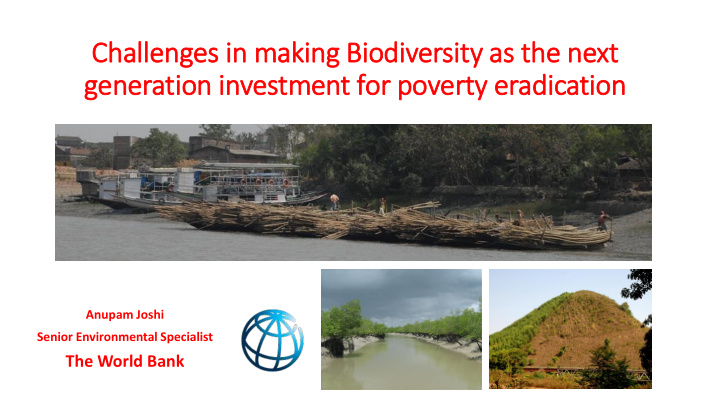



Challenges in in making Bio iodiversity as the next xt generation in investment for poverty eradication Anupam Joshi Senior Environmental Specialist The World Bank
Key challenges? • Generally believed that infrastructure led growth model lifts a higher proportion of people out of poverty • How to Overcome perception? How to address wealth distribution? • India – poverty reduced but inequality increased • Investments in biodiversity are smaller, fragmented, and at community level who are generally poorly skilled • As opposed to large infrastructure contracts • Biodiversity/forests as pathways out of poverty known but not sure if these models will work at scale?
Global Poverty Scenario… • p
What the Bank is doing? • Generating awareness that biodiversity/forests provide vital resources • Participation in global/national/sub-national events • Analytical work to show that poor are highly dependent on biodiversity/forests for incomes • Business case for governments for investing more on forests • Designing projects to influence larger programs and securing land rights • Leveraging financing for scaling up good practices in biodiversity conservation • Piloting investments to test if natural resource based livelihood models can operate at scale • New focus on reviving marine and inland fisheries sector – blue economy
Generating awareness and mapping what’s happening to biodiversity? www.worldbank.org/biodiversity
Establishing links between natural resources and economic welfare Direct Impact – > studied Direct consumption or sale Natural Income, Resource Welfare (Forests) Input in Output production Indirect Impact – > CGE, hedonic price approach, contingent valuation methods………
Forests can help reduce poverty ! 90,000 Income from other sources • Household level dependence estimated (in India) 80,000 • Poor more dependent in relative terms – 25% to Livestock net income 70,000 30% of income • 60,000 Agricultural net income Forest incomes equals agriculture income for poor Income (Rupees) households 50,000 • Income from businesses Not so poor continue to use forests • 40,000 They generate MORE income from the Wage income from paid environment than poorer households. work 30,000 • Implies continued dependence Non-forest 20,000 • Female headed households are more dependent on environmental income the environment for their income 10,000 Total Income from • Forests critical resources for over 100 million extreme Fishing and Aquaculture 0 poor within India Bottom 20-40% 40-60% 60-80% Top 20% Total Direct and forest- 20% derived income Income Quintile
Is Poverty and Forest Cover Linked? - Globally Forest Land Area and Adjusted Net Natioanl Income Per Capita of Different Regions 60 Percentage of Forest Land Area 50 Latin America and Caribbean 40 30 Sub Saharan African World East Asia and Pacific 20 South Asia 10 Europe and Middle East and Central Asia North Africa Bubble size is % forest area 0 0 1000 2000 3000 4000 5000 6000 7000 8000 9000 10000 Adjusted Net National Per Capita Income in $ Data Source: Little Green Data Book (2015), World Bank
Is Poverty and Forest Cover Linked? – Nationally Data Sources Poverty: Chief Economist Office, World Bank Forest: Hansen data set • High forested areas are not always also high poverty areas • Low poverty areas may also not be low forested areas
Our options • WB twin goals – end extreme poverty and boost shared prosperity allow us to use a range of approaches/instruments • Poverty Reduction Strategy Paper (PRSP) • Country Partnership Strategy/Frameworks • Investments • Development Policy Operations • Investment Projects • Program For Results
Key focus areas of the Bank in Biodiversity • Addressing policy failures • Enhancing environmental governance and public sector capacity • Building resilience through investing in natural infrastructure across landscapes • Generating financial flows
What the Bank is doing on biodiversity? • Going beyond GDP – Natural Capital Accounting • Wealth Accounting and Valuation of Ecosystem Services (WAVES) • Spreading our environmental investment portfolio • Technical assistance to influence multi billion dollar forest investment program at the national and sub-national levels • Integrated Coastal Zone Management programs supporting millions of dollars in reviving mangrove forests • Stepping up on marine and inland fisheries 189 projects totaling $4.98 b operating in 90 countries
One Bank – many roles • Securing land rights: In Brazil, the Amazon Region Protected Areas (ARPA) program designated 24 million hectares of protected areas; significant portions of the newly created protected areas are on indigenous land. The indigenous people have received legal rights over the land and security of access to its resources in return for conserving the land. ARPA will prevent emission of 430 million tons of carbon by 2050 • Improving biodiversity resources: The Mozambique Conservation Areas for Biodiversity and Development Project is improving the grasslands/savannas for economic benefits of local population • Setting institutional arrangements: Setting conservation trust funds – Mexico / Bhutan • Leveraging funds: highly co-financed projects implemented by the World Bank only constitute 4 percent of the whole GEF portfolio but accounted for one-third of all co-financing. Without the Bank’s projects the GEF co-financing ratio would fall from 4.5:1 to 3.1:1 • Conservation partnerships: Establishing and supporting several multi-stakeholder partnerships – Global Tiger Initiative, Coral Triangle Initiative, Save Our Species, Critical Ecosystem Partnership Fund etc. • Piloting new approaches: Landscape conservation approach in India, Sahel, China, Ethiopia, Rwanda etc.
ENR GP New Business Lines Marine, Coastal & Aquatic Pollution Management & Sustainable Landscapes Environmental Health Forests, Watersheds & • Unlocking the • Managing • Reducing wealth of renewable Resources pollution to marine, natural capital coastal and improve across environmental fresh water landscapes economies conditions Clean and Resilient Growth Fostering economics and institutions for sustainable and sustained growth Environmental Risk Management & Sustainability Managing risks and creating opportunities to advance sustainable development
Thank you…. Questions/Comments ?
Recommend
More recommend